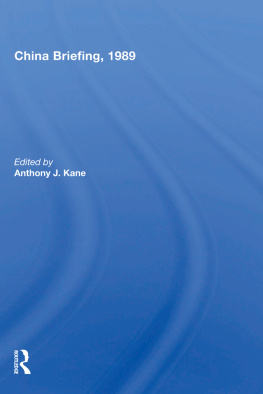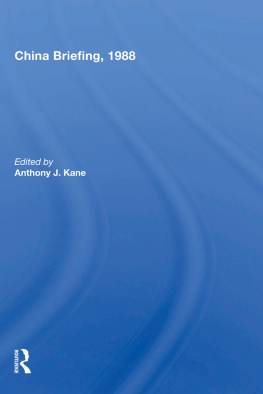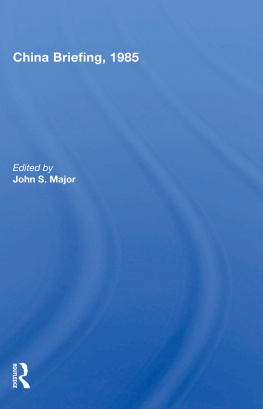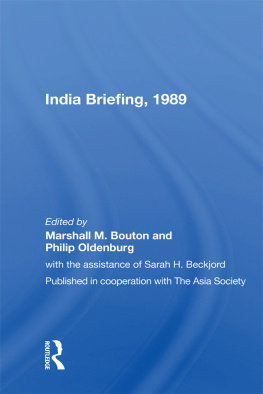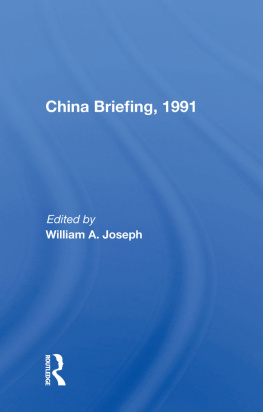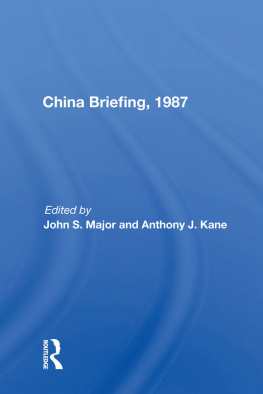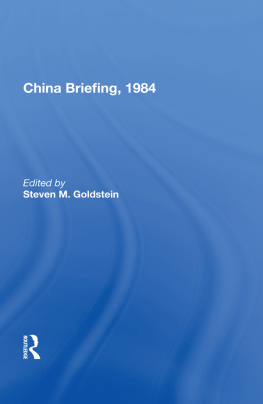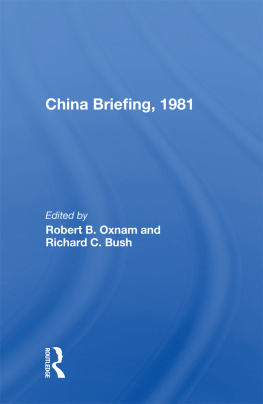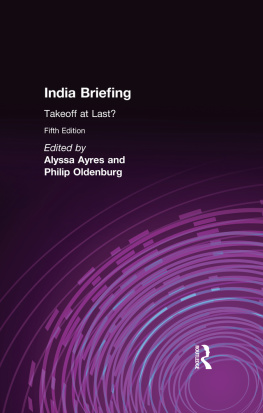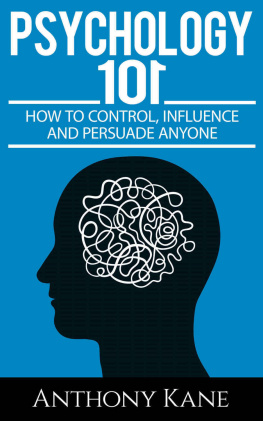China Briefing, 1989
edited by
Anthony J. Kane
Published in cooperation with the China Council of The Asia Society
First published 1989 by Westview Press
Published 2018 by Routledge
52 Vanderbilt Avenue, New York, NY 10017
2 Park Square, Milton Park, Abingdon, Oxon OX14 4RN
Routledge is an imprint of the Taylor & Francis Group, an informa business
Copyright 1989 by The Asia Society
All rights reserved. No part of this book may be reprinted or reproduced or utilised in any form or by any electronic, mechanical, or other means, now known or hereafter invented, including photocopying and recording, or in any information storage or retrieval system, without permission in writing from the publishers.
Notice:
Product or corporate names may be trademarks or registered trademarks, and are used only for identification and explanation without intent to infringe.
Library of Congress ISSN: 0740-8005
ISBN 13: 978-0-367-00343-2 (hbk)
As China Briefing, 1989 was going to press, the People's Republic of China (PRC) was experiencing a wave of student demonstrations on a scale unprecedented in the reform era. The catalyst for the protests was the death in April 1989 of Hu Yaobang, the former general secretary of the Chinese Communist Party. Hu had long been at the center of controversy over reform, and he was forced to resign after an earlier wave of demonstrations in December 1986. The debate inside the party following Hu's fall helped to build a new consensus behind the reforms that guided Beijing's policy in 1988.
This volume analyzes the impact of severe inflation and other setbacks that have seriously tested the consensus for reform over the course of the last year. Experts examine the year's developments in politics, the economy, foreign relations, and culture in the PRC. China Briefing, 1989 also includes a chapter on Taiwan and a special retrospective on the ten years since Sino-U.S. relations were reestablished in 1978. All of the chapters were specially commissioned for this volume, and we thank the authors for their hard work under rigorous deadlines.
China Briefing, 1989 is the ninth in a series of annual assessments of key events and trends in Chinese affairs prepared by the China Council of The Asia Society. The volume is the companion to India Briefing, also copublished annually by The Asia Society and Westview Press.
The China Council, a program of The Asia Society's Contemporary Affairs Department, is a nonprofit, nonpartisan educational organization committed to providing timely and accurate information on China and U.S.-China relations. Through the publication of the annual China Briefing, the China Council attempts to make available to a general audience a digest of the essential information on events of the previous year.
The editor wishes to thank the staff of the Contemporary Affairs Department for helping to bring this volume to press: Sarah Beckjord, Andrea Sokerka, Patty Binns, and Ellen Lenson were all indispensable at different stages of the project. Dorothy Grant provided excellent research assistance and fact checking, and Linda Griffin Kean and Chip Gagnon assisted in the final editorial and manuscript preparation tasks. And to Susan McEachern at Westview Press, our deepest appreciation for her continued support
Anthony J, Kane

Anthony J. Kane
As China Briefing, 1989 was going to press, China was in the midst of an upheaval of historic proportions. More than a million people demonstrated for two days in support of student protestors in Beijing's Tiananmen Square. The government declared martial law, and an extended standoff ensued. The significance of these events will be debated for years to come, but the contributors to this year's volume analyze the early signs of trouble in politics, the economy, culture, and the society as a whole.
The past year was a difficult one for China. Inflation was high, spirits low, and everybody from the top leadership to the man in the street seemed to be angry about something. In his chapter "Politics: Reform at the Crossroad," Andrew Nathan calls it a season of discontent unique in China's post-revolutionary history. Noting that senior leader Deng Xiaoping's instincts were already being questioned over the decision to introduce, and then quickly rescind, price reform, Nathan raises the possibility that the Third Plenum of the Thirteenth Central Committee of the CCP, held in September 1988, might have marked the death knell of the reforms that were born nearly ten years earlier in the Third Plenum of the Eleventh Central Committee of December 1978.
What went wrong? As Bruce Reynolds points out in "The Chinese Economy in 1988," to a large degree China's current problems are a product of the spectacular successes achieved in a decade of reform. Emboldened by that success, the leadership attempted to push price reform aheadwith disastrous results. Double-digit inflation wiped out the increased buying power Chinese consumers had enjoyed in recent years and was compounded by panic buying. Visions of the hyperinflation that helped bring down the Nationalist government 40 years earlier loomed in the minds of many Chinese. Popular support for the reforms began to erode, and by the end of 1988, inflation had become a bigger issue than political freedom.
Opponents of price reform used the consumer panic to justify curbing what they considered to be an overly ambitious reform agenda, but the problems proved to run much deeper. Attempts to reassert central authority had little effect, and even the reformers began to worry about surrendering too much control. Widespread corruption and crime led many of those commonly described as "liberals" in the Chinese political spectrum to espouse "the new authoritarianism," a theory that advocated limiting political freedom in order to provide stability at a time of rapid economic change. Ironically, its supporters pointed to the examples of Taiwan and South Korea to justify their contention that restricting democratic rights is essential to successful economic development.
Discontent with the status quo burst forth with unexpected power in April 1989, bringing the pending succession struggle to a head. Demonstrators turned out in ever-growing numbers in response to a series of events, beginning with the death of former CCP General Secretary Hu Yaobang on April 15. In the early 1980s Hu had been seen by many activists in China (and by outside observers, including this one) as the country's chief ideological watchdog, but after his fall he became a hero to those seeking greater freedom and democracy for China. The demonstrations following his death were reminiscent of those that had led to his resignation, but this time there was an important difference. When word spread that senior leader Deng Xiao ping had issued an order to suppress the demonstrations, the number of people in the streets jumped from tens of thousands to hundreds of thousands. The people's armed police pulled back and the suppression order was rescinded, leaving the students flush with a feeling of having won an unprecedented victory.







